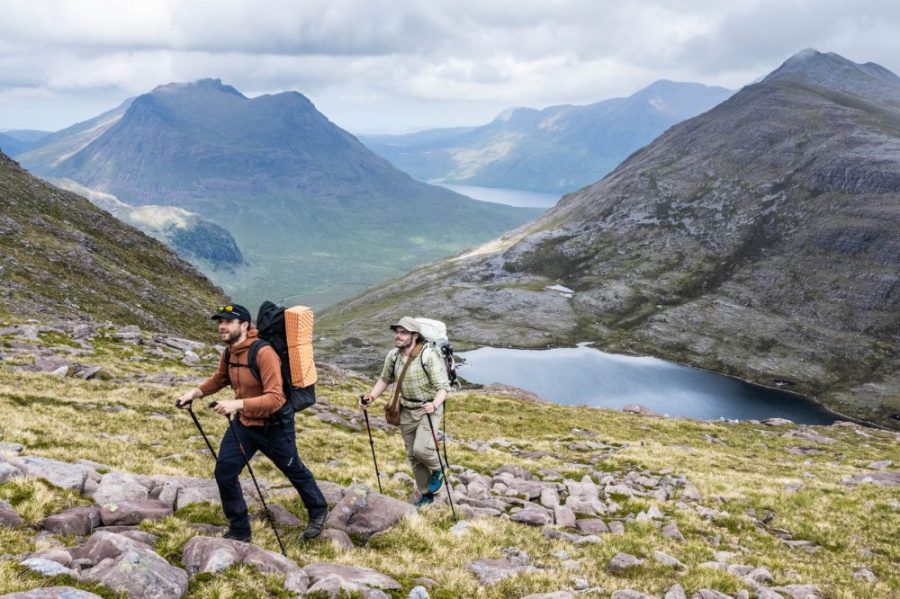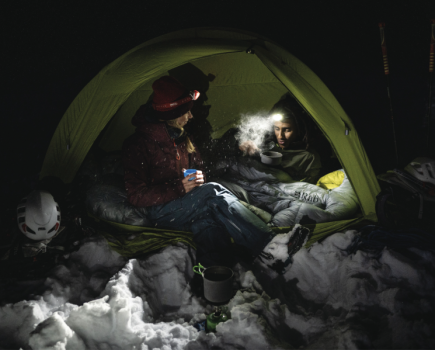Trekking poles, also known as trekking sticks or hiking poles, help you balance, save energy and protect your joints. They also reduce the chance of hip, back, knee or ankle injury as they create at least two or three points of contact on the ground at any one time to help to spread out our weight rather than the whole load going down through your hiking boots. When carrying heavier or multi-day loads they will also ensure that the larger load is shared between lower and upper body.
Main image: trekking in the Fisherfield Forest | Credit: James Roddie
Consider the difference between a path in your local park and the landscape of a remote mountain. As the terrain becomes more uneven, the practicality of trekking poles increases. When the trail runs out and you need to go off-track, hiking poles can then help to support your whole body as you navigate the lumps and bumps and things like bogs and rivers. Hiking poles allow us to ‘feel out’ these slippery unknowns before we enter them, gain purchase and transfer weight carefully from one limb to the next.
The same goes for snow and ice. That’s when poles provide extra security when crossing streams that are snow-covered and probing for weaknesses in the snowpack. Should the worst result and a limb needs to be ‘set’ in an accident, a trekking pole makes for an excellent splint – particularly if you wrap gaffer tape around the stem for emergencies. And for lightweight one-person tent or tarp users, they can even be used to hold up a shelter.
Why you can trust The Great Outdoors
The Great Outdoors is here to help you make the most of your time outside. We have been helping people to explore from sea to summit, valley to mountain top for over 40 years. Our gear tests remain completely impartial. If you are wary of websites that only review brands that advertise with them, or sceptical of social media accounts always singing the praises of their latest freebie, you’ve come to the right place! Our reviews rank #1 for rigour, trustworthiness, and independence, and our gear testing team is the most experienced in Britain. With over 200 years’ experience between us, we are professional mountain leaders and instructors, wildlife photographers and rangers, outdoor authors, guidebook writers and trail addicts.
The best trekking poles: our expert pick
This article highlights the results of extended trekking pole tests by our reviewer, Steph Wetherell with additional contributions from co-editor David Lintern. The hiking poles have all been judged and selected for their performance, durability, reliability and value.
| Quick List |
|---|
| Best locking mechanism: Black Diamond Pursuit (available from Black Diamond) |
| Best for simplicity: Black Diamond Trail (available from Black Diamond) |
| Best for durability: MSR DynaLock Ascent Carbon (available from Cascade Designs) |
| Best for lightweight adventures: Komperdell Carbon C3 Cloud Compact (available from alpinetrek.co.uk) |
| Best value: Harrier Catbells Aluminium Z-Fold V2 (available from Harrier) |
Best overall
Black Diamond Pursuit Trekking Poles
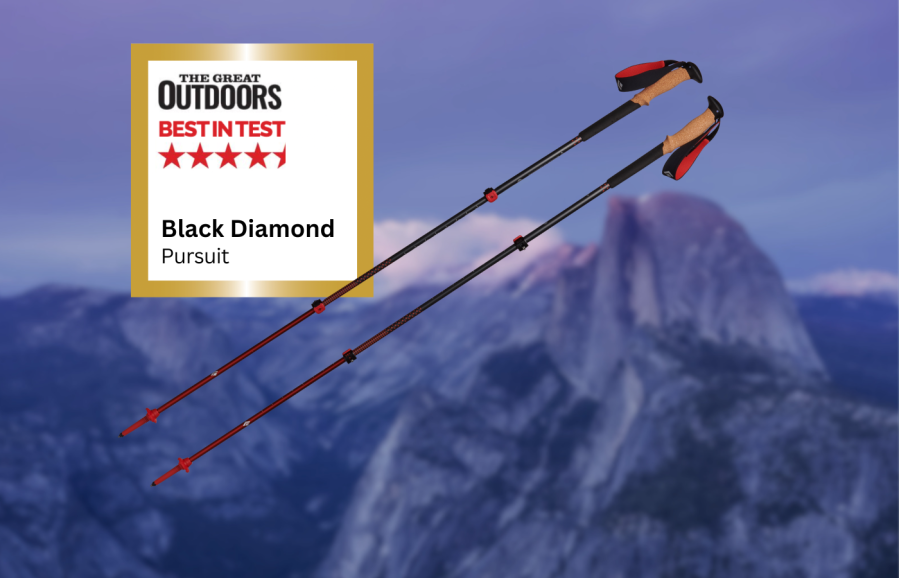
Steph Wetherell’s Best in Test
These telescopic poles are not as lightweight as some – but make up for the weight in quality.- Comfortable grip
- good locking mechanism
- none
| Quick specs |
|---|
| Price: $169.95 / £140 (available from Black Diamond) Weight: 462g (S/M) Length: S/M 100-125cm (62cm collapsed), M/L 100-140cm (68cm collapsed) Shaft: Aluminium Grip: Cork with foam extension Adjustment: FlickLock+ softtouch blackdiamondequipment.com |
These are high quality telescopic trekking poles with an assortment of premium. While the Black Diamond Pursuit Trekking Poles are not as lightweight as some of the most expensive carbon fibre poles, they are at the light end of the aluminium market and bring the durability of the aluminium construction.
The grips are a standout feature of these poles. Black Diamond have recognised that hand sizes varies hugely and the S/M size option comes with a smaller grip size. I have a unisex M hand and am 5’10, and the S/M fit well. The main grip is really well shaped and comfortable to use all day, and I found the cork material was preferable to foam, especially when my hands were sweaty on a hot day or long climb.
The length adjustment flick locks felt incredibly high quality and were very easy to use, and the tightness of the lock can be adjusted using a hex tool that is nestled inside the internal end of one of the poles. You have to remember which part of which pole has the tool in, but means in-field repairs are easy and the mechanism is less likely to get clogged with mud than a wheel.
Read more: Steph’s full review of the Black Diamond Pursuit poles
Simple design
Black Diamond Trail
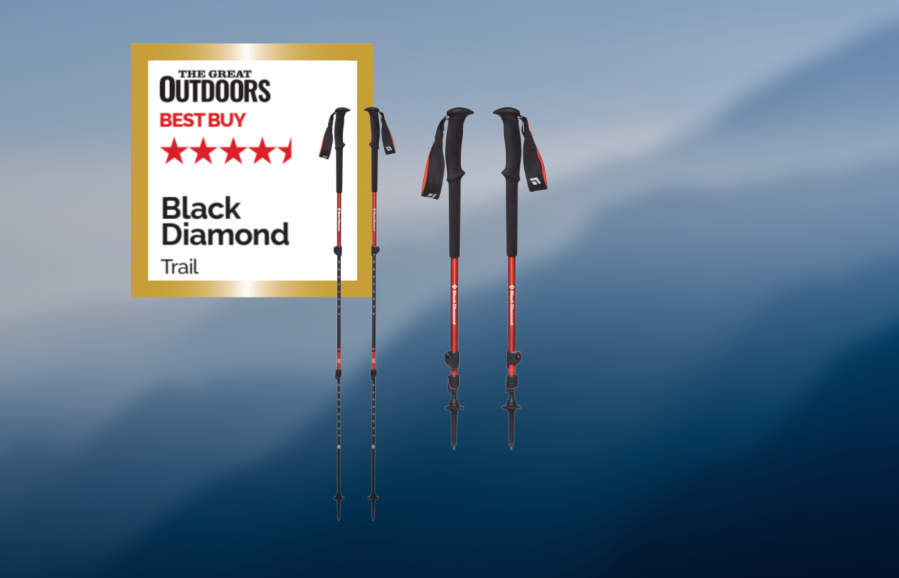
David Lintern’s Best in Test
The Black Diamond Trail trekking pole is a personal favourite, despite being quite a heavy trekking pole.- price
- durability
- not the lightest
| Quick specs |
|---|
| Price: $120 | £95 (pair) (available from blackdiamondequipment) Weight: 256g each Length: packed length 64cm, fully extended 140cm Shaft: Aluminium Grip: Foam Adjustment: 3-section pole, flick lock system blackdiamondequipment |
The Black Diamond Trail is a tried and true trekking pole whose strength lies in its simplicity. It’s a 3-section aluminium pole with instantly readable measurements in metric given on the lower two sections, and a good range of height adjustability.
The foam handle is well suited for medium-sized hands and comes in a single, long piece, with very basic moulding for the bottom of the palm. In combination with a reasonable price, the Black Diamond Trail is an excellent offering that gets my recommendation.
Read more: David’s full Black Diamond Trail review
Most durable
MSR DynaLock Ascent Carbon poles
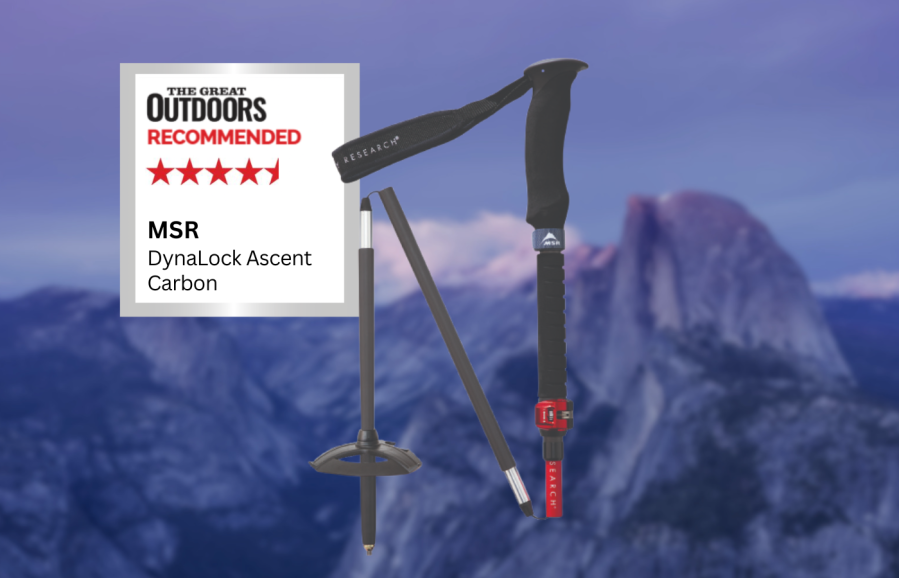
TGO Magazine verdict
The kevlar-reinforced carbon makes these MSR poles feel sturdier than many carbon fibre poles.- light
- sturdy
- strong flick lock mechanism
- Size options may exclude some people
| Quick specs |
|---|
| Price: $189.95 / £170 (available from Cascade Designs) Weight: 442g (S/M) Length: S/M 100-120cm (36.2cm), M/L 120-140cm (44.5cm) Shaft: Kevlar reinforced carbon fibre Grip: Foam, including extension Adjustment: FlickLock+ softtouch cascadedesigns.com |
These poles are fairly lightweight but offer more durability than many carbon fibre poles and are a worthy investment for people looking for lightweight but long lasting poles. The kevlar-reinforced carbon does make them feel sturdier than many carbon fibre poles, and I found very little vibration when using them – even on rockier sections. They come with a summer trekking basket as well as a larger snow basket.
The grip is comfortable and fits well in my hand, but the lower extension is slightly separated from the main grip – the strap to hold the collapsed pole together sits in this gap – but it makes the lower extension slightly more clunky to use. The size and shape of the extension is good though, and comfortable to use when ascending hills.
The top of the pole is well shaped for descents, and the wrist strap is padded and easy to adjust. The Z pole assembly mechanism is easy to use, and I found they were very quick to put up and down. The Dynalock flip lock is a particular highlight, designed so that the pole sections fold up compactly against each other when dismantled, making them simple and straightforward to pack away inside a pack.
Read more: Steph’s full MSR Dynalock Ascent trekking poles
Lightest in test
Komperdell Carbon C3 Cloud Compact
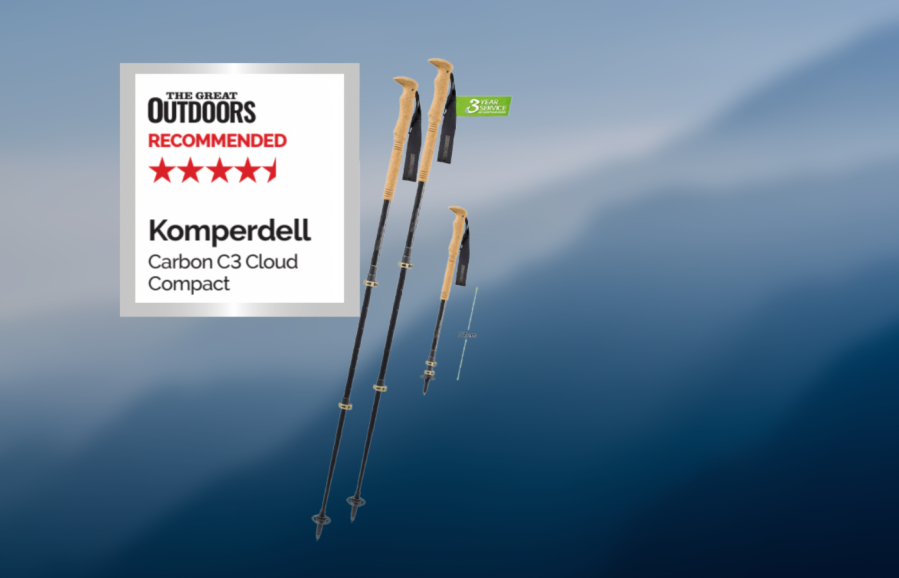
David Lintern recommends
The Carbon C3 Cloud Compact from Komperdell is a very lightweight pole, but despite that it is very tough and well-designed.- small packed length
- lightweight
- very rigid
- good handle
- irregular shaft diameter (won’t accept connector for pyramid tarp use)
- expensive
| Quick specs |
|---|
| Price: $120 | £130 (available from alpinetrek.co.uk) Weight: 206g each Length: packed 57.5cm, fully extended 121cm Shaft: carbon Grip: Foam Adjustment: 3-section pole, flick lock system cascadedesigns.com |
The Cloud Compact from Komperdell is the lightest trekking pole in this test, but very tough and well-designed. It’s a three-section, all-carbon pole, with the sections being adjusted by flick locks. In use, the use of carbon throughout means the weight balance shifts towards the upper third of the pole, but they are so lightweight overall they are hard not to enjoy using.
Read more: David’s full Komperdell Carbon C3 Cloud Compact review
Silva Trekking Poles Carbon
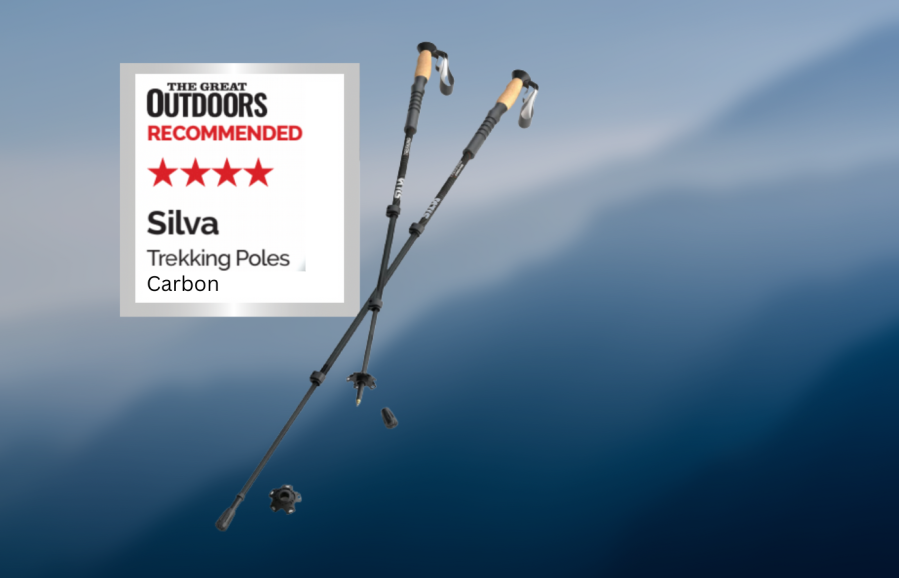
David Lintern recommends
A lot of thought has gone into the Silva trekking poles carbon, which are lightweight, comfortable to use and exceptionally robust. It’s a three-section pole with a good range of adjustable height.- comfy handle material
- robust in use
- lightweight
- large handle
- flick lock adjusters prone to snagging
| Quick specs |
|---|
| Price: $136 | £120 (pair) (available from Winfields Outdoors) Weight: 215g each Length: packed length 66cm, fully extended 140cm Shaft: carbon Grip: cork Adjustment: 3-section pole cascadedesigns.com |
Silva all-carbon trekking poles are lightweight, comfortable to use and exceptionally robust. The handles are luxurious and provide excellent sweat management, but the grips are on the large size, even for my ‘size large’ hands. Thinner carbon poles tend to bend or wobble under strain, but these are well-made, wider-diameter shafts that have held a shelter up in high winds without complaint. In conclusion, there’s lot to recommend here, especially if you have big mitts.
Read more: David’s full Silva Trekking Poles Carbon review
Best value
Harrier Catbells Aluminium Z-Poles V2
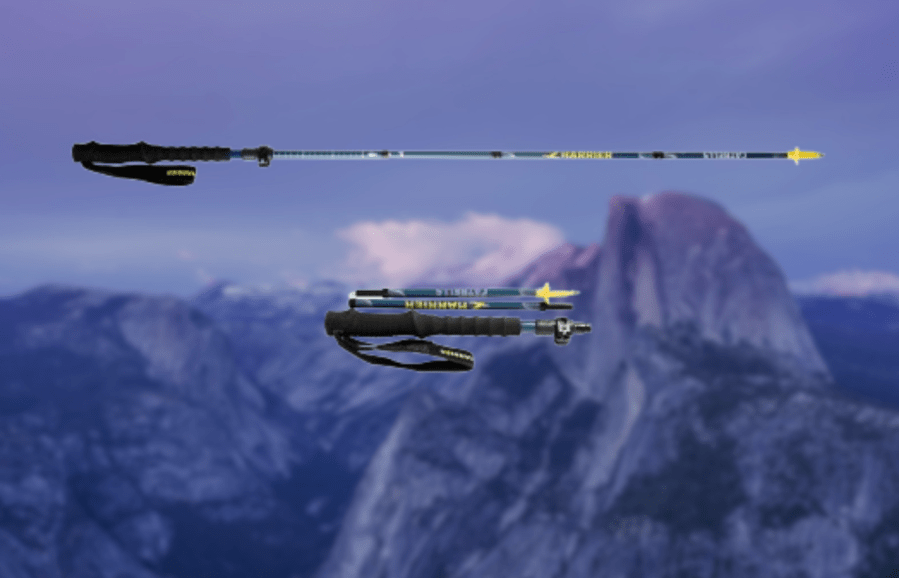
Steph Wetherell’s Best Value
Good value and ideal for beginners, there is one downside to these poles, primarily designed for trail runners.- affordable
- excellent extended grip
- Integrated baskets aren’t ideal
- no proper top to poles
| Quick specs |
|---|
| Price: $80 / £59.99 (available from Harrier) Weight: 502g Length: 110-125cm (35cm collapsed) Shaft: Aluminium Grip: Foam, including extension Adjustment: FlickLock harrierrunfree.co.uk |
They are surprisingly lightweight for the price point, pack down fairly small and offer a decent adjustment range. I found them quick to assemble, and the metal height adjustment flick lock felt secure and well designed, and easy to adjust using a small integrated wheel.
The aluminium poles themselves felt sturdy and trustworthy when using, and the wrist strap is comfortable, soft and easy to adjust. The grips are ok – they are better than a lot of other entry level poles, but don’t match the comfort of a more expensive pair. The shaping on the main part of the grip didn’t quite seem to fit my hand, but I really liked the undulating shaping on the extended grip section, and found it made these easier to use on ascents.
One drawback though is the lack of a shaped top to the pole – it may be that this hasn’t been prioritised as runners are one of the key target audiences for these poles, but I found the lack of a proper top made them less comfortable to use on descents.
Read more: Steph’s full Harrier Catbells trekking poles review
Leki Makalu Lite
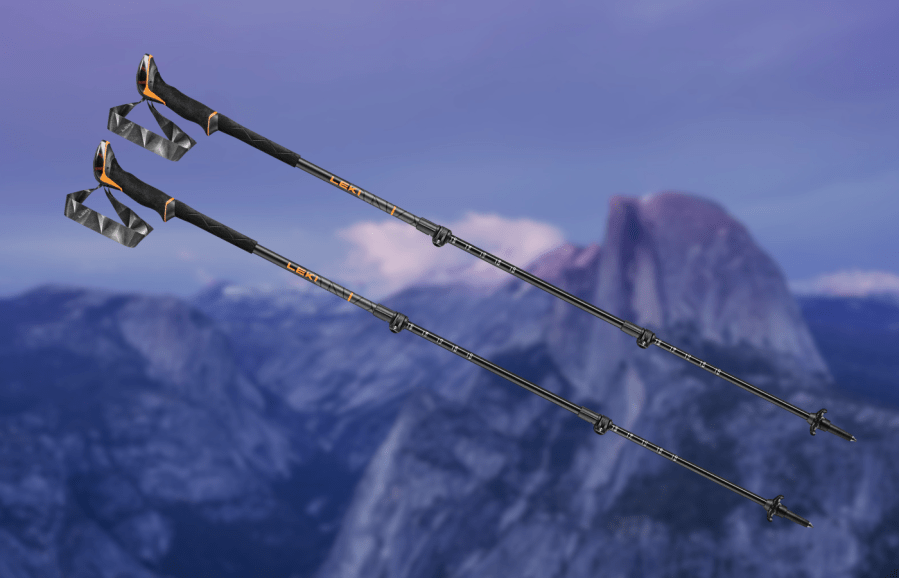
TGO Magazine verdict
The ‘Aergon Air’ grip is a triumph of comfort but the wrist strap on these poles could be improved.- comfortable grip
- disappointing wrist strap
- no snow basket
| Quick specs |
|---|
| Price: $159.95 / £115 (available from Leki USA and Cotswold Outdoor) Weight: 485g Length: 100-135cm (67cm collapsed) Shaft: Aluminium Grip: Foam, including extension Adjustment: FlickLock leki.co.uk |
The ‘Aergon Air’ grip is a triumph of comfort. The main grip itself is well shaped and comfortable enough, but the top of the pole is the highlight, curving over slightly further than other poles.
It has an incredibly grippy top and subtle shaping underneath that made it wonderfully comfortable when descending big hills. I found it just naturally sit in my hand and felt intuitive to use. The wheel adjustable flick locks are plastic in construction but felt pretty sturdy. They aren’t the smallest when collapsed, but they are reasonably lightweight for aluminium poles and felt sturdy to use.
The poles come with smaller removable trekking size baskets, but not snow baskets, which will limit their use for some. These poles sits at the mid-price point, and as such are is not the lightest or most packable pair of poles, but they are sturdy and reliable.
Read more: Steph’s full Leki Makalu Lite review
Salewa Carbonium Ascent Poles

David Lintern’s verdict
In use, the poles proved secure and rigid, but the use of carbon in the upper sections and aluminium lower down means the pole feels unevenly weighted at the tip.- very robust
- ball basket design
- weighted heavier at tip end
| Quick specs |
|---|
| Price: $159.95 / £115 (available from salewa.com) Weight: 232g each Length: packed 68cm, fully extended 138.5cm Shaft: carbon (upper) and aluminium (lower) shafts Grip: Foam Adjustment: Flick Lock system salewa.com |
The Carbonium is a three-section, composite pole – the upper two are carbon and the lower third is aluminium. Each section is held together with flick locks, tensioned by recessed Phillips screw. In use, the poles proved secure and rigid, but the use of carbon in the upper sections and aluminium lower down means the pole feels unevenly weighted at the tip.
Read more: David’s full Salewa Carbonium Ascent Poles review
Trekmates Fold Lock
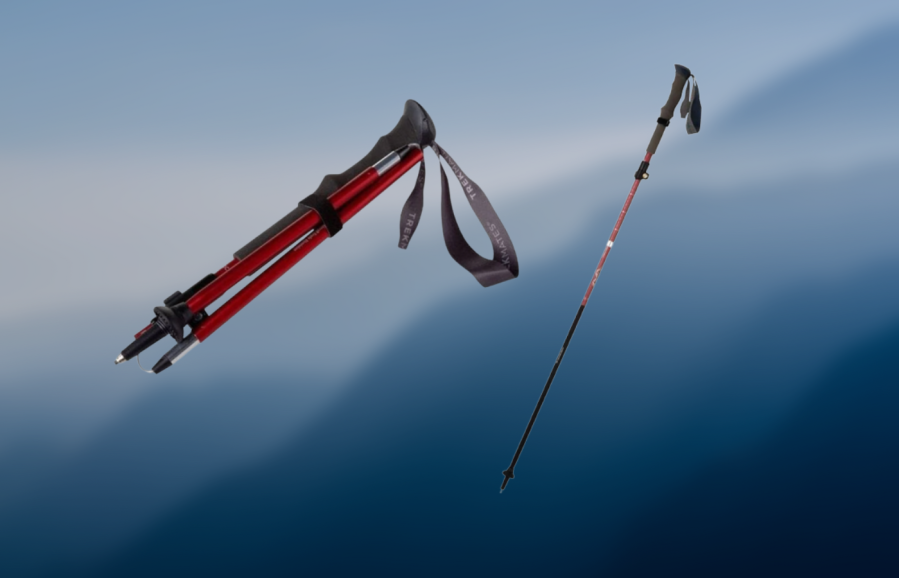
David Lintern’s verdict
The Trekmates are a budget option and would be my personal choice when it comes to poles that incorporate a folding lock system.- cost
- small when packed
- solid shaft
- small lower handle
- fold lock system not as durable
| Quick specs |
|---|
| Price: $40 / £30 (available from gooutdoors.co.uk) Weight: 269g each Length: packed length 35cm, fully extended 125cm Shaft: Aluminium Grip: Foam Adjustment: Fold lock system with flick lock height adjuster trekmates.co.uk |
The Trekmates are the budget option here for trekking poles and would be my personal choice of the two in this review that incorporate a folding lock system. It’s advertised as a five-section unit, but in practical use it’s four. The pole sections are ‘aircraft grade’ aluminium (marketing speak for ‘tough’?). and the unit is held together by a plastic-coated wire cord.
Read more: David’s full Trekmates Fold Lock review
How we test
Steph tested these trekking poles in all weathers throughout early 2025 in the Brecon Beacons and the South West of England. She uses trekking poles a lot when walking, and always uses them on ascents and descents, especially steep hills. Weights are from her digital scales (pairs).
David tested these poles on a wide mix of ground, from multiday backpacks to his local trails on days out with the kids, right across Scotland from Spring 2022 through to Autumn 2022. Weights are from his digital scales and for individual poles (not pairs).
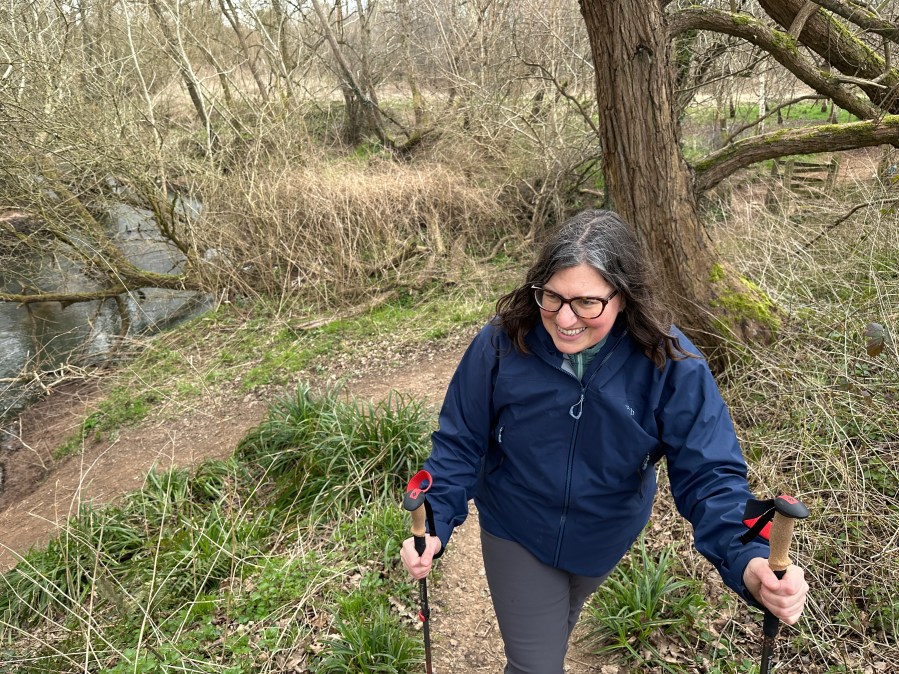
How to choose the best trekking poles for you
As someone with a degree of hyper-flexibility in my knees, trekking poles have long been part of my hiking kit. Here’s what to look out for.
Material
The quality of the poles and the material that the poles are made from will affect the weight. Aluminium poles are cheaper but heavier, although more high end aluminium poles often weigh significantly less than the entry level options. Carbon fibre poles are lighter but come at a higher price point and are more prone to breaking.
Locking mechanism
There are two main types of poles – telescopic poles that collapse into themselves and are locked by a twist or level lock, and foldable or Z poles that have a cable running through them and fold down. Foldable poles usually collapse down to a smaller size, making them ideal for situations where you want to store or transport them inside a pack, but many day-packs have an attachment system that is better suited to telescopic poles.
Adjustment
Poles usually have an adjustable range, so check the height range that the pole is suitable for before buying. Some poles will have different length options, and if you are particularly tall or short, there may be brands that are better suited to you.
Grip
The grip is a key factor in the comfort of using poles for an extended period of time. The material and moulding of the grip varies significantly – cheaper brands may have plastic grips, with more expensive options opting for foam or cork. The moulding is also important – especially if you have small hands – and some brands are now offering different grips on their smaller size poles to address this. Another thing to look out for is an extended grip section, where there is a second padded section below the main grip. This means you can put your hands on this section during steep ascents without needing to adjust the height of the pole itself. This feature is commonplace on higher quality poles but often missing on entry level versions.
Learn more about how to choose the right poles for you.
What are the benefits of using trekking poles?
Like many people I once held a bit of prejudice towards trekking poles. Initially seeing them as props for the old, injured or overweight, eventually I came to my senses after borrowing a friend’s poles for a hike – I’d asked for them as I was worried about a niggle in my knee flaring up. Not only did they prevent any injury from occurring but they genuinely seemed to make hiking feel easier – and faster.
I’ve since come to really appreciate what trekking poles bring to the table. On rocky terrain and river crossings, they add an enormous amount of stability; on steep ascents they give you an extra two limbs to haul yourself up with and on downhills they give two extra limbs to take a bit of pressure off the knees.
Many articles cite a 1999 study purporting that trekking poles take as much as 25% of strain off your joints. Since then, there have been some opposing viewpoints saying that this is an exaggeration. Speaking from personal experience, I do find that trekking poles are absolutely brilliant for making hiking with a heavy backpack less strenuous. There have been thru hikes I’ve done in the past where I’ve had absolutely no regrets about bringing poles with me, including on a west coast to east coast hike across Scotland and on a 300-mile hike through Wales.
There are times that I’ll forgo poles though and it’s normally be when I don’t have a heavy pack. In these instances, I prefer to have my hands free for when I want to scramble, pull out a map and compass to navigate or lift up my camera to get a shot. If I’m hiking with friends, with my dog or on a busy crowded trail, I’ll sometimes opt to hike without poles just so I don’t run the risk of tripping or spiking someone accidentally.
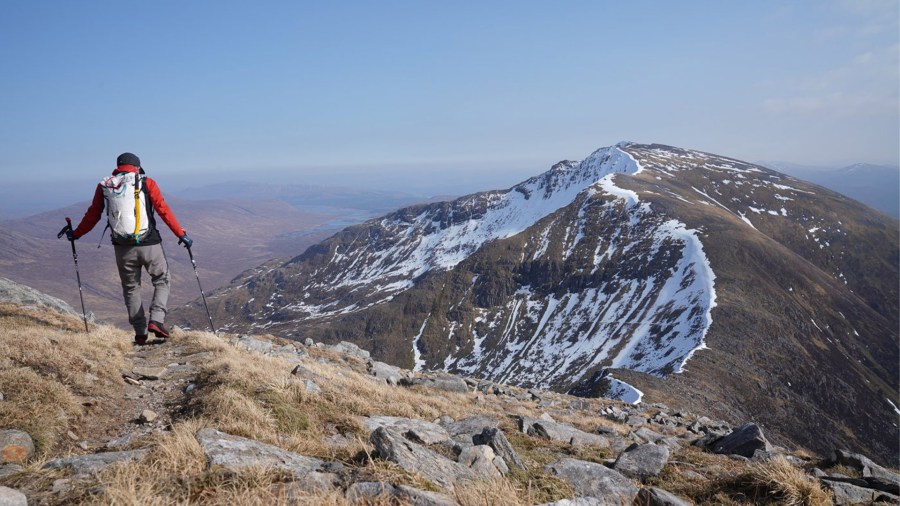
How to master your trekking pole technique
We once published an article titled ‘The problem with trekking poles’ which gave some of our readers opinions on the use of poles. The consensus seemed to be that trekking poles are beneficial but that’s only if they are used correctly.
Start by making sure the poles are adjusted to the right height. With the tips touching the ground and the poles bolt upright, your elbows should roughly be at a 90 degree angle when holding the poles.
The grip should be held lightly, with a nice and relaxed, natural grip. Try not to grip too tightly, as this can get tiring and it could even lead to an injury.
You also need to ensure that you are using the strap correctly. Do this by inserting your hand through the strap from below. It should then loop around the back of your hand and then come over the top of your hand.
As I go, I like to adjust the pole length accordingly based on the terrain I’ll encounter during my hike. For steep uphill sections, I’ll shorten the poles slightly for more leverage, and for steep downhill sections, I’ll lengthen them.

What materials should trekking poles be made of?
Trekking poles are commonly made from aluminum or carbon fiber. Aluminum poles tend to be affordable, durable, and they have a good strength-to-weight ratio. They’re also more environmentally friendly than some other options as aluminum has a higher recyclability.
Carbon fiber poles are lighter and ideal for ultralight backpacking and they also have excellent vibration dampening. The downside is that they tend to be more expensive and, to some extent, they can be easier to break. Steel poles, which you don’t see so often anymore, are the heaviest and most robust and are suitable for extreme conditions. Ultimately, you’ll often find that poles are made from a combination of different materials to strike a balance.
Don’t forget the pole handles too. From my experience, rubber is good but it can be sticky in hot conditions. Foam tends to wear down and fall apart and plastic is best avoided as it gets slippery when it’s wet. My favourite material? That’s cork. Overtime it naturally moulds to your own hand, it’s grippy, moisture-absorbent, breathable and it’s eco-friendly too.

